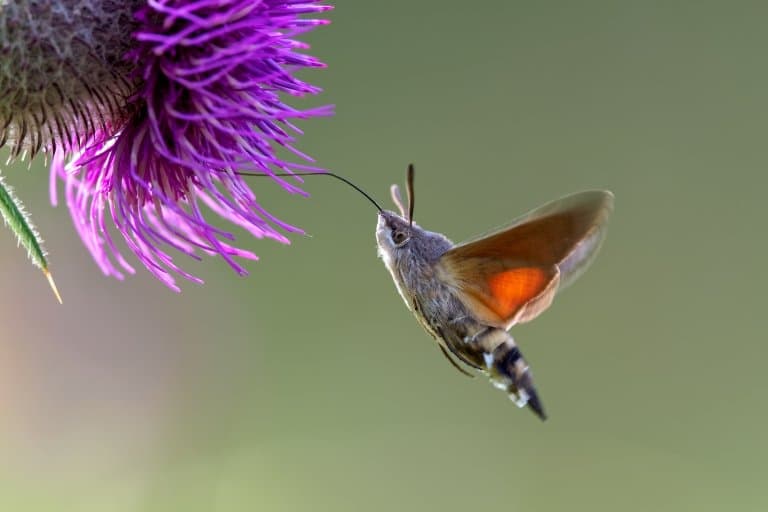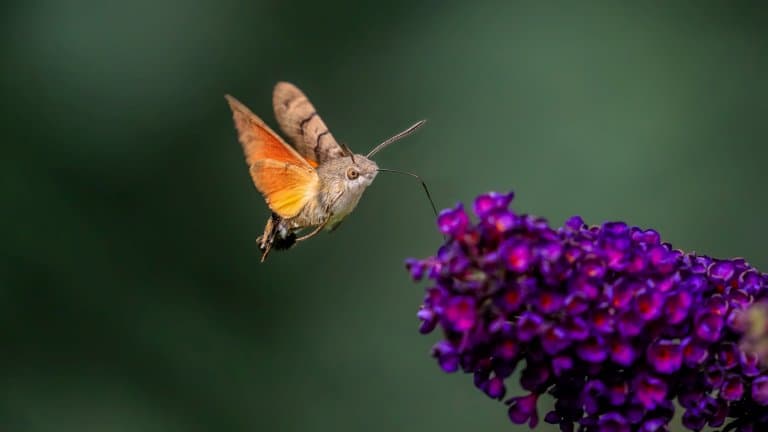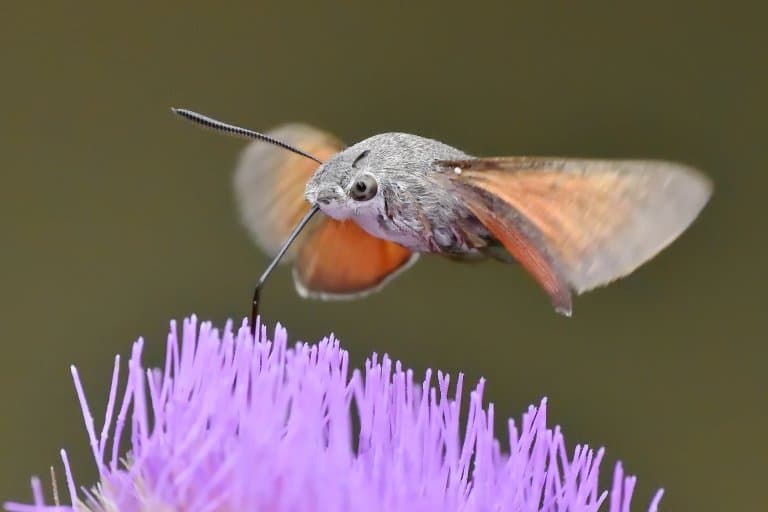Hummingbird Hawk-Moth Profile
The hummingbird hawk-moth is a species of hawk moth, which is named due to its striking similarity to hummingbirds. Hawk moths are numerous species in a family of moths, all distinguished by their agile and sustained flying ability.
They are most common across Europe and Asia, with some populations appearing in the northern countries of Africa. Like many other types of hawk moths, the hummingbird hawk moth relies on flowers as their main food source.

Hummingbird Hawk-Moth Facts Overview
| Habitat: | Gardens, parks, meadows, forests with high flower populations |
| Location: | Northern Africa, Europe, Continental Asia |
| Lifespan: | 7 months |
| Size: | Wingspan of 40 to 45 millimetres (1.6 – 1.8″) |
| Weight: | <1gram |
| Color: | Brown forewings and orange hindwings with black markings |
| Diet: | Flower nectar |
| Predators: | Birds of prey, bats |
| Top Speed: | 19 kph (12 mph) |
| No. of Species: |
1 |
| Conservation Status: |
Not listed |
Hummingbird hawk-moths can be found in gardens, meadows, parks and woodlands where there are nectar-rich flowers that it diets upon. Their favourite plants are is Galium (bedstraw) and Rubia (wild madder), as well as red valerian, honeysuckle, jasmine, Buddleia, lilac, Escallonia, petunia and phlox.
Caterpillars can generally be found between June to October, and they overwinter as adults in crevices in walls, trees or outbuildings before cocooning among plant debris or leaf litter.
As adults, they grow up to around 2 inches in length and have brown-orange hindwings. It has forewings that are brown-grey and a black and white chequered body.
Hummingbird hawk-moths are an important type of pollinator. However, they’re often not seen as important pollinators since they don’t pollinate crops like bees do. While they may not help in the agricultural industry, though, like all types of hawk moths, they’re essential to the life of many native plants. Without them, many animals would fail to thrive in the wilderness.
As far as reproduction goes, hummingbird hawk-moths produce groups of eggs known as broods. A single female can lay hundreds of eggs, which hatch in around a week. However, she doesn’t lay each egg together. Instead, she flies around, laying each egg on its own individual plant.
The hummingbird hawk-moth convervsation status is unlisted, but are not under any threat, with large populations and widely distributed.
Interesting Hummingbird Hawk-Moth Facts
1. Yes, they are a moth
It’s easy to mistake these incredible animals as birds, but as their name (half) suggests, they are moths. But not like you usual moth that comes out at night.
They are a day-flying moth, with an appearance of tail feathers, and the ability to fly and feed like a hummingbird! They are pretty to look at, which can be unlike other moths!
They are also far more robust than your usual moth or butterfly, capable of feeding from flowers even in the rain. 1

2. They’re not the same as hummingbird moths
When it comes to common names, things can get tricky. However, it’s important to know that hummingbird moths and hummingbird hawk-moths aren’t the same thing!
The hummingbird hawk-moth is known by the scientific name Macroglossum stellatarum. As a result, it is in the genus Macroglossum. This species in particular finds its home in the region known as the Old World, which is made up of Europe, Asia, and Africa.
The hummingbird moth, however, is in a completely different genus, Hemaris. They are still a member of the Sphingidae family, though, making them distantly related to hummingbird hawk moths. This species is more common in the New World, which includes North and South America.
3. They’re a prime example of convergent evolution
If you watch a hummingbird hawk-moth eat, you may notice that they’re extremely similar to a hummingbird. They use their long straw-like mouthpiece, known as a proboscis, to suck the nectar out of flowers.
This is an example of convergent evolution. Convergent evolution is when completely different species with little to no relation, such as a moth and a bird, develop similar features for the same purpose.
In this case, the hummingbird’s mouth and the hummingbird hawk-moth’s proboscis are examples of convergent evolution. 2
4. They are capable of “swing-hovering” or “side-slipping”
This is the ability to move rapidly from side-to-side while hovering.
It’s thought this ability evolved to help evade ambush predators that lay awaiting them in flowers. They can in an instant side-step any danger!
5. Their wings beat at 70-80 times a second
They even emit an audible humming noise as they hover over plants.

6. They have a routine
Most of the time, when you see insects like moths, butterflies, and bees flying around, it doesn’t seem like they have a plan. When they land, it seems random, and they don’t appear to have a preference for certain flowers. However, that’s not always true.
Hummingbird hawk-moths do what is known as trap-lining. This means that they are thought to return to the same flower beds around the same time each and every day.
They have also demonstrated a preference for certain types of flowers.
7. Their favorite flowers are those with longer, tube-like shapes
Everything is nature faces competition. This is because there are simply not enough resources to support everything. Trees have to compete for sunlight, animals for space and food – this is the circle of life in the wilderness.
As a result, hummingbird hawk-moths tend to favor flowers where they face the least amount of competition. For deeper, narrower plants, it can be difficult for insects like bees to reach the nectar inside. However, the hummingbird hawk-moth is able to utilize its long proboscis to reach the food source within.

8. Hummingbird hawk-moths see better with less eyes
Like many other types of insects, the hummingbird hawk-moth has several eyes, more than the two we are used to seeing on animals.
However, as far as multi-eye insects come, the hummingbird hawk-moth is actually on the end of the spectrum with fewer eyes. Their eyes are more complex, though, allowing them to see more. 3
9. They’re named for the appearance of their larvae
The hummingbird hawk-moth is a part of the family Sphingidae, which is made up of all types of hawk moths, also known as Sphinx moths.
This is because of the fact that young hawk-moths, before they become moths at all, look like the ancient Egyptian cat.
10. We know their entire genome
Since they were discovered, genetics has also been a topic of intrigue in the science community.
The hummingbird hawk-moth was first described in the 1700s, when nomenclature, or scientific names, emerged. As of 2018, we’ve been able to completely understand their genome. This means that we know all of their genes!

11. Hummingbird hawk moths are considered a sign of good luck
These tiny insects have a big message packed in their little body. Around the world, many cultures consider the hummingbird hawk-moth as a symbol of good luck.
This goes along with the usual meaning for moths overall, which can be linked to transformation and change.
Hummingbird Hawk-Moth Fact-File Summary
Scientific Classification
| Kingdom: | Animalia |
| Phylum: | Arthropoda |
| Class: | Insecta |
| Order: | Lepidoptera |
| Family: | Sphingidae |
| Genus: | Macroglossum |
| Species Name: |
Macroglossum Stellatarum |
Fact Sources & References
- BBC News (2017), “Unusual hummingbird hawk moth ‘defies myths’“, The BBC.
- Timothy B. Sackton, Nathan Clark (2019), “Convergent evolution in the genomics era: new insights and directions“, Royal Society.
- R. Kern & D. Varjú (1998), “Visual position stabilization in the hummingbird hawk moth, Macroglossum stellatarum L. I. Behavioural analysis“, Journal of Comparative Physiology.
